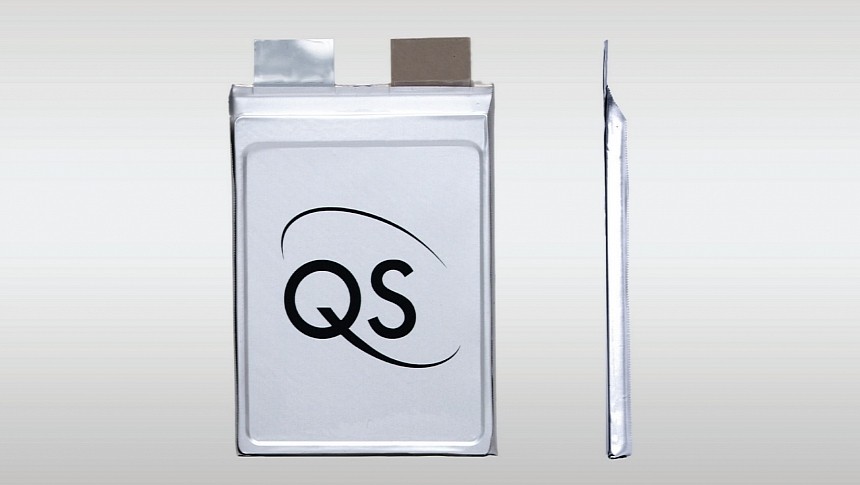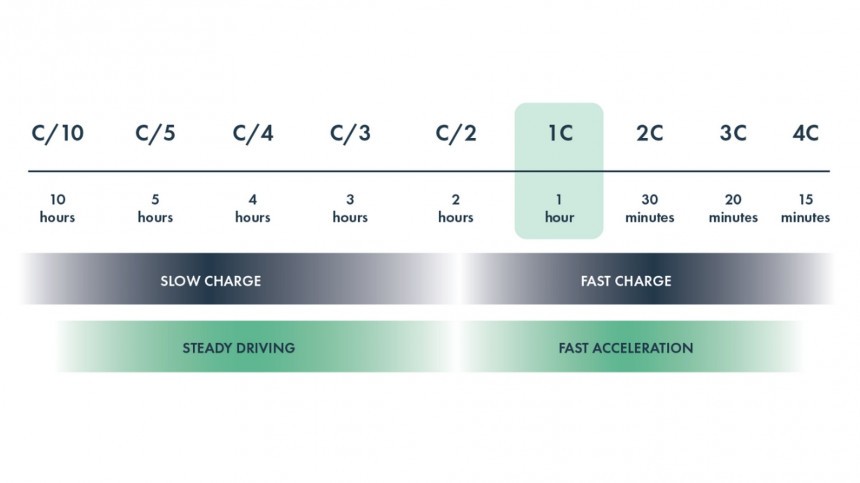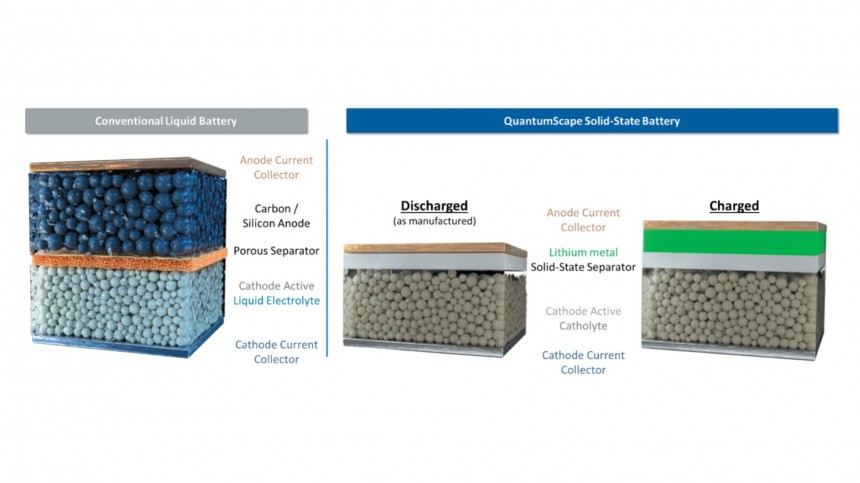Those who follow QuantumScape are certainly familiar with the company's commercial target. The solid-state platform startup wants to ensure its cells can reach 800 cycles while retaining at least 80% capacity. After it shipped its A0 24-layer cells to customers, one of them said they had attained 1,000 cycles while the battery still had 95% capacity.
As QuantumScape liked to clarify, a 300-mile battery pack that reaches 800 cycles with minimal losses would be able to power a battery electric vehicle (BEV) for almost 240,000 miles. Considering most automakers will only replace a battery pack if its capacity drops below 70% capacity, a car with QuantumScape cells could have a quite reasonable lifespan with the commercial target alone. By reaching 1,000 cycles with a capacity of 95%, it would have allowed the car to run almost 300,000 miles and would still be very far from dying.
That's excellent news not only because of what it represents for BEVs but also because these tests were made by one of the companies that will use these cells in their vehicles. That will give them the confidence to purchase as many cells as QuantumScape can sell when they are ready. Volkswagen will undoubtedly be the first to get them. Although QuantumScape did not disclose which customer tested these A0 cells, it is almost certain that it was the German automaker.
It is important to stress that the tests were not as rigorous as those QuantumScape has used to evaluate its solid-state cells so far. The startup and independent tests have charged and discharged these batteries at 1C, meaning that a full charge and a full discharge were made in just one hour. In other words, that's fast charging, considered crucial for BEVs to be as convenient as cars powered by internal combustion engines (ICEs). QuantumScape wants its cells to go from 10% to 80% state of charge (SoC) in 15 minutes.
The customer tests were made by charging at C/3 (3 hours or 180 minutes) and discharging at C/2 (2 hours or 120 minutes). Independent evaluations performed at 1C showed they retained more than 90% capacity after 800 cycles. This explains why Toyota, Honda, and several other companies are waiting for solid-state cells to go all-in into BEVs: anything created with the current cell technology will become obsolete when these new batteries are finally for sale. QuantumScape wants its commercial cell to be available in 2024. That's next year.
The solid-state platform startup always stresses that its technology is related to the ceramic separator it managed to develop. This component allows QuantuntumScape cells to use any chemistry (including LFP) and to be anode-free: that role is played by a lithium metal layer that forms at the other end of the ceramic separator. The company's first cell will be called QSE-5, and it will have high cathode loading. That means the cathode active material (CAM) will be higher in these batteries, which translates into a high energy density.
If the company manages to deliver that, the BEVs with QSE-5 will have much lighter battery packs for the range they can offer. CATL is also after that market with its Condensed Cells. They promise to deliver a 100-kWh battery pack that tips the scale at only 200 kilograms (440.9 pounds). Battery packs used nowadays with the same capacity weigh three times as much. The lower mass will also contribute to longer ranges and more energy efficiency. Safety will also face a massive improvement.
In its Q3 2023 letter to shareholders, QuantumScape also disclosed the commercial name for its proprietary battery format: FlexFrame. It is a hybrid design that mixes prismatic and pouch cells. One side of the battery is flexible to allow it to expand when the lithium metal layers form in all its 24 layers. QuantumScape said this expansion adds only one millimeter (0.04 inch) to the battery's thickness. Still, you'll never notice that: it sits flush with the prismatic frame when fully charged and retreats while discharging.
Apart from the QSE-5, QuantumScape is also considering the consumer electronics market. It developed single-layer cells that some customers in this market are testing, and they have already achieved between 1,500 and 2,000 cycles while retaining around 80% of charge capacity. The startup said that this represents 1.5 to 4 times what some of these electronics can survive. Again, these cells should be extremely light, which may help make smaller gadgets without charging concerns. Most smartphone owners complain about how often they have to recharge their devices.
QuantumScape said it still has a lot of work to do when it comes to reliability, scaling up production, and improving quality. Despite that, it said it is not "aware of any automotive-format lithium-metal battery that has shown such high discharge energy retention over a comparable cycle count, at room temperature and modest pressure, regardless of C-rate." We have no details on CATL's Condensed Cells, but they are the only contender the American startup may face. Hitting the market first may not be the main challenge here: proving to solve some of BEVs' main hurdles will be way more critical.
That's excellent news not only because of what it represents for BEVs but also because these tests were made by one of the companies that will use these cells in their vehicles. That will give them the confidence to purchase as many cells as QuantumScape can sell when they are ready. Volkswagen will undoubtedly be the first to get them. Although QuantumScape did not disclose which customer tested these A0 cells, it is almost certain that it was the German automaker.
It is important to stress that the tests were not as rigorous as those QuantumScape has used to evaluate its solid-state cells so far. The startup and independent tests have charged and discharged these batteries at 1C, meaning that a full charge and a full discharge were made in just one hour. In other words, that's fast charging, considered crucial for BEVs to be as convenient as cars powered by internal combustion engines (ICEs). QuantumScape wants its cells to go from 10% to 80% state of charge (SoC) in 15 minutes.
The solid-state platform startup always stresses that its technology is related to the ceramic separator it managed to develop. This component allows QuantuntumScape cells to use any chemistry (including LFP) and to be anode-free: that role is played by a lithium metal layer that forms at the other end of the ceramic separator. The company's first cell will be called QSE-5, and it will have high cathode loading. That means the cathode active material (CAM) will be higher in these batteries, which translates into a high energy density.
If the company manages to deliver that, the BEVs with QSE-5 will have much lighter battery packs for the range they can offer. CATL is also after that market with its Condensed Cells. They promise to deliver a 100-kWh battery pack that tips the scale at only 200 kilograms (440.9 pounds). Battery packs used nowadays with the same capacity weigh three times as much. The lower mass will also contribute to longer ranges and more energy efficiency. Safety will also face a massive improvement.
Apart from the QSE-5, QuantumScape is also considering the consumer electronics market. It developed single-layer cells that some customers in this market are testing, and they have already achieved between 1,500 and 2,000 cycles while retaining around 80% of charge capacity. The startup said that this represents 1.5 to 4 times what some of these electronics can survive. Again, these cells should be extremely light, which may help make smaller gadgets without charging concerns. Most smartphone owners complain about how often they have to recharge their devices.
QuantumScape said it still has a lot of work to do when it comes to reliability, scaling up production, and improving quality. Despite that, it said it is not "aware of any automotive-format lithium-metal battery that has shown such high discharge energy retention over a comparable cycle count, at room temperature and modest pressure, regardless of C-rate." We have no details on CATL's Condensed Cells, but they are the only contender the American startup may face. Hitting the market first may not be the main challenge here: proving to solve some of BEVs' main hurdles will be way more critical.



























